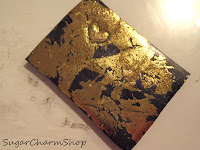Baking polymer clay
I feel like I havn't made a post in such a long time, even though it's only been 3-4 days.
I want to talk about baking polymer clay, whether it's charms, miniatures or figurines - I often get questions on my YouTube channel, asking me at what temperature I bake my things, for how long and how I avoid burning the clay etc.
*I dette indlæg vil jeg snakke om bagning af polyler (Cernit, Fimo) Hvilken ovn, hvor lang tid, hvordan man kan undgå at brænde leret mm.*
The very basics:
At what temperature should you bake your clay?
Always check the package - it will tell you the temperature you should bake that specific brand at and how long you can bake it. A lot of brands will say 15-30 minutes, and they'll only have a small difference in the temperature setting. eg. Fimo says 110 degrees celcius, I believe?, and Cernit says 130 degrees celcius... Those have been my 2 favorite brands since I started working with polymer clay, so I do mix them a lot when making my miniatures and charms, and I do take that into consideration when baking. Usually I'll bake my creations at around 110-120 degrees celcius, just so that I don't bake the Fimo at a temperature that's way too high.
For how long should you bake your creations?
Again, check the package - as I mentioned above a lot of brands have a time frame of 15-30 minutes. I most often bake my creations for 20-30 minutes.
If you underbake, the polymer clay won't obtain its full strength and will be more prone to breaking. This can also happen if you overbake, so stay within that time frame but don't take it out of the oven too soon.
Polymer clay is a fairly strong and durable medium but it's not unbreakable. When working with dollhouse miniatures it's not as great a concern as it is when making jewelry - Though both dollhouse miniatures and jewelry should be treated with respect, and shouldn't be thrown around or dropped.
What type of oven?
Kitchen oven: A lot of people have heard that you can't use your kitchen oven to bake polymer clay because of fumes and toxins... Don't worry, you can use your regular oven, but don't burn the clay (this is what causes the "fumes" that so many talk about). However, I remember reading a post on an online forum about this person who'd forgot to turn his/her oven off when leaving the house (while the polymer clay was still in the oven). He/She had a pet bird that was sitting in the room, and though the clay had been baked for way too long and had been burnt, the bird was just fine. Of course I'd suggest following one guideline; If you're going to use a regular kitchen oven (I do), have a special baking tray ONLY for polymer clay. That's really the only concern - don't use a tray that you're going to use for food. You can use a regular baking tray, put baking paper on and then bake your polymer clay, that way you can still use the tray for food since it hasn't been in contact with the polymer clay.
Toaster oven: .... well, I know that MANY use toaster ovens for their polymer clay projects and I can understand why you might want to use one; it's smaller and easier/cheaper to heat up. It's used just for your crafts so you don't have to worry about any "toxins" and it's convenient because you can have it standing in your craft room/corner without taking up a lot of space and so forth.
I've tried baking clay in a toaster oven a couple of times, and my experience is that they're way too hard on the clay. My pieces ended up being discolored or a lot more fragile, so this is not a type of oven I'll be using ever again for clay.
Microwave: No... nope... DON'T!,..
Tips for baking:
You know how the bottom of the clay piece (the one touching the baking tray) becomes flat or misshapen? That really annoyed me when making three dimensional objects (mainly charms and dolls), and I know that most times you'll be able to cover it up or you won't even notice it because it's the bottom, but sometimes that's just not good enough. I found this ceramic fibre blanket on metalclay.co.uk. It only cost 3.95£.
This is probably one of the best things I've purchased, clay wise, for a long time. In the picture I was just about to bake my "Olsen banden" before making the hands and feet. This blanket is such a great thing to have, especially when making dolls that have their heads turned so the ears won't get squeezed flat. I also use it when making miniature "half pigs/large butcher pieces" that are going to be hanging and have to look good from all angles.
Making a tent out of tin foil is the easiest way to avoid burning the clay. It can probably still burn if you bake it long enough, but I havn't had that happen, even if I've baked something for 40 minutes.
Let me know if you have any other questions in regards to baking polymer clay :)
Let me know if you have any other questions in regards to baking polymer clay :)





















